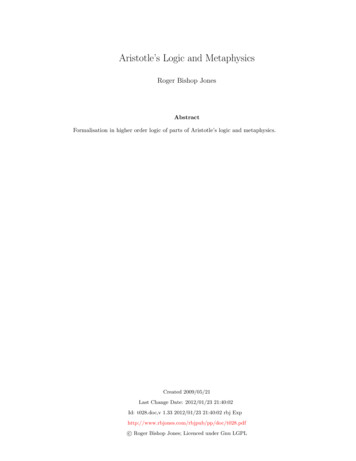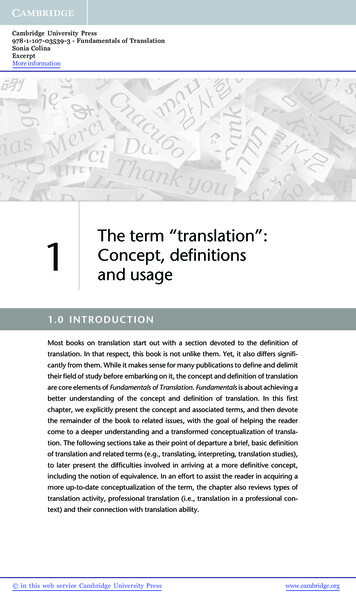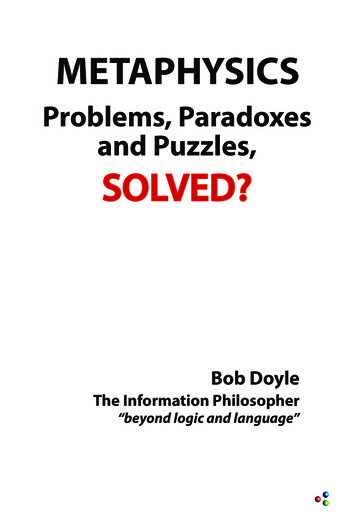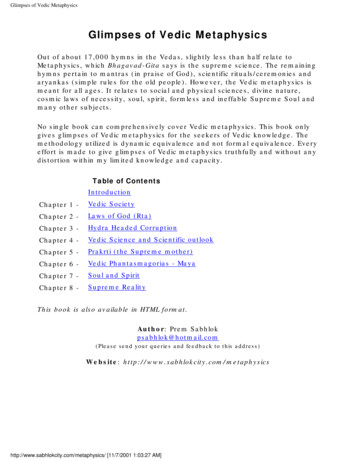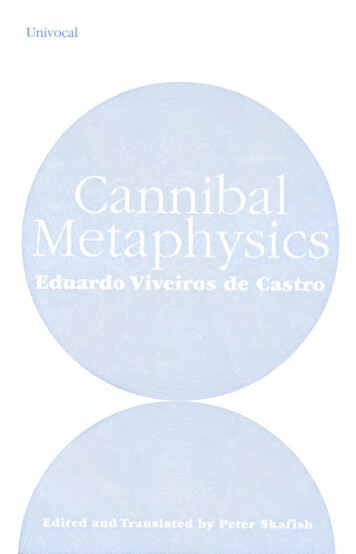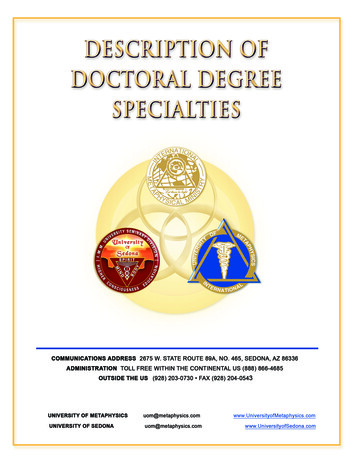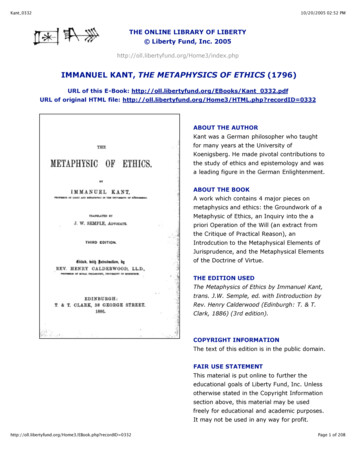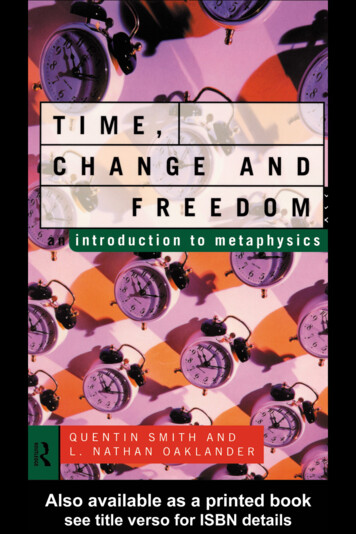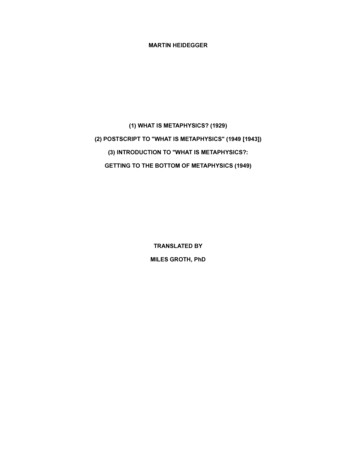
Transcription
MARTIN HEIDEGGER(1) WHAT IS METAPHYSICS? (1929)(2) POSTSCRIPT TO "WHAT IS METAPHYSICS" (1949 [1943])(3) INTRODUCTION TO "WHAT IS METAPHYSICS?:GETTING TO THE BOTTOM OF METAPHYSICS (1949)TRANSLATED BYMILES GROTH, PhD
TRANSLATOR’S INTRODUCTORY NOTETranslations of Heidegger are usually not good English, but they can be. It is, of course, impossible toreconfigure German as English since German formations follow rules of sense and nonsense that aredifferent from English formations. But it is possible to bring Heidegger over into English.Heidegger is colloquial, idiomatic and playful. His German is steeped in literature, especially in theauthors who transformed and enriched the German language: Meister Eckhart, Luther, Goethe, Lessing,Herder, Schiller, Hölderlin. Heidegger sometimes gives leeway to assonance for clues about wordsformed on the same root. He builds with echoes and then plays on the linguistic structures disclosed,which reveal the sense embedded in the words.Reading Heidegger in German, we accompany his discoveries of sense in the German language. Hismeans of unfolding meaning in the German language can often be applied to other languages, such asEnglish, where the new language can be freed for its own playfulness, poetry and idioms.I have never felt that Heidegger was unclear or deliberately obscure. He wrote a great deal and, Isuspect, fluently. Then, returning to what he had written, a week later or decades later, he discoveredwhat he had been given by language. He would then rewrite, emend, gloss, edit, qualify, expand what hehad written.In this translation I do not hope to solve Heidegger's ambiguities or explain them away. I only want totranslate the ambiguities expressed in German into ambiguities expressed in English.The three texts translated below are separated from each other by fourteen and six years, respectively.On July 24, 1929, Heidegger gave his inaugural lecture "What Is Metaphysics?" to the combined facultiesof the University of Freiburg. He wrote a postscript to this "letter" to his colleagues for the fourth edition ofthe publication of the lecture in 1943. For the fifth edition (1949) he added an introduction to the lecture,
entitled "Getting to the Bottom of Metaphysics [Der Rückgang in den Grund der Metaphysik]."Though published together in logical order (introduction, lecture, postscript), Heidegger also presentedthem chronologically in his anthology Frontier Markers [Wegmarken] beginning in 1967. The order ofpresentation there makes more sense, since as the title of Heidegger's book indicates, each text markshaving reached a new frontier in his thinking. By contrast, his other anthology Dead Ends [Holzwege]indicates experiments in thinking that were in a certain sense blind alleys.Heidegger describes the postscript as a preface or foreword. In that sense it should come first, followedby the introduction, as is the custom in the format of a book. Or perhaps the postscript should bring usback to the lecture itself. The order of reading would then be introduction, lecture, postscript, and lectureagain.For Heidegger, an introduction such as his "Introduction into Metaphysics" from 1935 or "Getting to theBottom of Metaphysics" has pedagogical significance, but like the introduction in a piece of classicalmusic, it is designed to bring the listener into the world of the main theme. It serves to set the mood forthe piece.I have translated the three frontier markers translated grouped around the lecture "What Is Metaphysics?"in the order of composition. The postscript was revised for the fifth edition (1949) of the lecture. In anearlier English translation, published that year, the unrevised postscript was the basis for the translation.The present translation is based on the Gesamtausgabe edition of Wegmarken (Volume 9, 1976) and soincludes marginal notes gleaned from Heidegger's copies of the various editions of his lecture.The order of composition of the three essays which follow was lecture (1929), postscript (1943, rev.1949), and introduction (1949). Nonetheless, I am presenting them as Heidegger did beginning with thefourth edition (1943) of the lecture. In Wegmarken, they are presented chronologically in order ofcomposition.11In a note to the first publication in French of a translation of the Introduction ("La Remonté au
All citations are to the Gesamtausgabe edition of Wegmarken (1976) (Frankfurt: Klostermann): "Einleitungzu 'Was ist Metaphysik?'" [ EWM and page number], pp. 365-383; "Was ist Metaphysik?" [ WM andpage number], pp. 103-122]; and "Nachwort zu 'Was ist Metaphysik?'" [ NWM and page number], pp.303-312.What Is Metaphysics? The lecture was presented to the faculties of the University of Freiburg on July24, 1929 as Heidegger's inaugural address. It was first translated by R.F.C. Hull and Alan Crick in 1949and published in Existence and Being, a collection of Heidegger's essays edited by Werner Brock(Chicago: Henry Regnery), pp. 325-349. The lecture and postscript (1943 version) have been reprintedsince 1975 in the revised and expanded edition of Walter Kaufmann's Existentialism from Dostoevsky toSartre (New York: New American Library), pp. 242-257. A second translation of only the lecture, by DavidKrell, was published in Basic Writings (1977) New York: Harper and Row (expanded edition, 1993), pp.93-110.Postscript to 'What Is Metaphysics?' The postscript was published with the fourth edition (1943) of thelecture. In this version, it was included with the Hull/Crick translation of the, ibid., pp.349-361, and inKaufmann, ibid., pp. 257-264. Heidegger revised the postscript for the fifth edition (1949). That version istranslated below.Introduction to 'What Is Metaphysics?'. Getting to the Bottom of Metaphysics The introduction waswritten in 1949 and published with the lecture and revised postscript. It first appeared in a translation byWalter Kaufmann, in 1956, in Existentialism from Dostoevsky to Sartre (revised edition [1975], pp. 265279).Fondement de la Métaphysique"), the translator, Joseph Rovan observes that the Introduction"est conçu comme une préface à une postface [was conceived as a preface to a postscript]"to the lecture. Fontaine (Paris) 10, #58, March 1947, p. 888.
INTRODUCTION TO "WHAT IS METAPHYSICS?"GETTING TO THE BOTTOM OF METAPHYSICS (1949)2Descartes wrote to [Claude] Picot3, who translated the Principia Philosophiae into French: "Ainsi toute laPhilosophie est comme un arbre, dont les racines sont la Métaphysique, le tronc est la Physique, et lesbranches qui sortent de ce tronc toutes les autres sciences . . ."4Staying with this image, we ask, in what soil [Boden]5 do the roots of the tree of philosophy find their2Another possible version of the subtitle is "The Nothing at the Heart of Metaphysics." Theadjective 'rückgängig' can mean "null and void" [nichtig]. Thus the subtitle suggests that theground of metaphysics is no-thing [das Nichts], which is the message of the lecture. For thistranslation of 'das Nichts', see the lecture. Notes preceded by (*) are Heidegger's marginaliagleaned from his copies of the various editions of the lecture.3Heidegger's citation is to René Descartes, Oeuvres, edited by Charles Adam and PaulTannery (Paris: Vrin, 1971 [1897-1910]), Volume IX,2, p. 14. Descartes' letter to Abbé Picotconstitutes his introduction to the Principia in Picot's translation. For information on Picot, seeDescartes' Correspondance, Volume V (1947) Paris: Presses Universaires de France, pp. 402404. The current translation, by John Cottingham, of the "Preface" is in John Cottingham,Robert Stoothoff and Dugald Murdoch (eds.), The Philosophical Writings of Descartes (1985)Cambridge: Cambridge University Press, Volume I, p. 186.4"Thus the whole of philosophy is like a tree, whose roots are metaphysics, the trunk ofwhich is physics, and the branches which extend out from that trunk are the rest of the sciences."5 In this translation, frequent interpolation of the original German terms will be made.Sometimes an entire sentence will be given in a footnote. Other times, a variant rendering will
support? From what ground6 do the roots and the tree as a whole receive their vital nourishment andstrength? What element, utterly hidden, controls the supporting and nourishing roots of the tree? Whatlies buried and is active in the essence [Wesen]7 of metaphysics? What does metaphysics look like atbottom? What is metaphysics at bottom after all?It thinks of be-ing [das Seiende]8 as be-ing. Wherever it is asked what be-ing is, be-ing as such is in view.be given, again in a footnote. This procedure is often decried as interfering with the flow of thetext. It is doubtful than anyone reading the text will regret not having to turn back to the originalGerman, especially when its inclusion strengthens the attempt to understand Heidegger'smeaning. Besides, the study of Heidegger's texts requires and repays the labor of long reflectionon the play of language in them.6Heidegger will play on two senses of 'Grund': the soil in and out of which living things growand the basis or grounds or reasons for something, presented as evidence for coming to a certaindecision about it. I will translate 'Grund' with "ground," "grounds," "basis" or even "at the heartof." "In den Grund" is rendered "at bottom." The phrase "Grund und Boden" is translated as"earth" or "land," the earth one farms or tends. "Grund und Boden" also functions idiomaticallyto mean "utterly." "Im Grunde" becomes "at the heart of," "fundamentally," "really," or "at (the)bottom (of)."7Sometimes 'Wesen' is translated "nature."8By 'das Seiende' Heidegger has in mind effective actuality, real "goings on" of any kind, incontrast with the "nothing going on" of no-thing [das Nichts].
Metaphysical formulating [Vorstellen]9 owes this view to the light*10 of be[ing] [Sein].11 The light itself(what such thinking experiences as light, that is) no longer comes into view in this thinking, because itpresents be-ing always and only with respect to be-ing. In view of this, metaphysical thinking certainlyasks about an actual [seienden] source and creator [Urheber] of the light. From this alone it is evidentenough that every perspective grants a view [Durchsicht] of be-ing.However be-ing may be explained, whether as spirit [Geist] in the sense of spirituality [Spiritualismus], as9 An important theme of the Introduction is how asking a question [eine Frage zu vorstellen]has become, in metaphysics, formulating, designating, proposing, making suppositions andapodeictic assertions [Vorstellungen], professing, representing (that is, or presenting something asecond time and therefore in a second version), assigning meanings -- rather than letting thosemeaning emerge on their own. To formulate or designate as metaphysics does is to affirm asincontrovertibly true, almost as a confession of faith. In professing, metaphysics also invariablypromotes what it proposes. It seeks to further itself and what it puts forward. By contrast,teaching, like poetic speaking, is quite different from professing. The phenomenological ideal,we recall, is knowledge without belief.10Heidegger's marginal notes in his copies of the various editions of the lecture are includedin the Gesamtausgabe edition of Wegmarken. They will be cited with edition number.*Fifth edition (1949): "Lichtung [illuminating]." (EWM 365) The term "light" is used inthe phrase "in light of."11With this term, Heidegger announces the 'be-' ['das Sein'] in 'be-ing' ['das Seiende'], that is,the 'Sei-' (root) of 'das Seiende'. I choose the form 'be[ing]' to underscore how awkward thismust come to sound. This linguistic contraption is meant to give pause. I pronounce it 'be'. In acertain way, the bare infinitive 'be' has been the most questionable matter for Heidegger'sthinking.
becoming [Werden] and being alive [Leben], as formulation [Vorstellung], as will [Wille], as substance[Substanz], as subject [Subjekt], as energeia, or as the eternal return of the equivalent [ewige Wiederkehrdes Gleichen]12, be-ing appears as be-ing each time in light of be[ing]. Whenever metaphysics formulatesbe-ing, it has there shed light on be[ing]. Be[ing] has arrived with[in] emergence [Unverborgenheit]( Αλήθεια).13 Whether and how be[ing] brings such emergence with it, whether and how it brings itselfalong*14 into and as metaphysics in the first place remains obscure. Be[ing] is not thought in its disclosingnature [entbergenden Wesen], that is, in its truth. Nevertheless, in its answer to the question about be-ingas such, metaphysics speaks out of an unnoticed obviousness [Offenbarkeit] of be[ing]. We can thereforecall the truth of be[ing] the ground in which metaphysics as the root of the tree of philosophy is supported,by means of which it is nourished.12For this translation of 'die Gleiche', see my essay "Who Is Heidegger's Nietzsche," a reviewarticle of the English translations of Heidegger's Nietzsche (1960).13The sense is of something stepping out of the shadows or coming out of seclusion and beingturned over to someone after having been in hiding. As Αλήθεια, emergence is determined ashaving been deprived or relieved of forgetfulness (λήθη) by be[ing]. Perhaps "emergedness"would work here.14*Fifth edition (1949): "An-bringen: Gewähren die Unverborgenheit und in dieserUnverborgenes, Anwesendes. Im Anwesen verbirgt sich: An-bringen von Unverborgenheit, dieAnwesendes answesen läßt. 'das Sein selbst' ist das Sein in seiner Wahrheit, welche Wahrheitzum Sein gehört, d.h. in welche Wahrheit 'Sein' entschwindet [bringing along: affording /granting of emergence, and in this emerging, apprésenting (making present to). In apprésentingis hidden the bringing along of emergence, which apprésenting lets itself apprésent. 'Be[ing]itself' is be[ing] in its truth, truth which belongs to be[ing], that is, truth in which 'be[ing]'vanishes]." (EWM 366)
Because metaphysics questions be-ing as be-ing, it is left to be-ing and does not turn to be[ing] asbe[ing]. As the root of the tree, it sends nourishment and strength out into its trunk and branches. A rootbranches out into the land [Grund und Bogen] and so, for the good of the tree, goes out of it and thus cantake leave of it. The tree of philosophy grows out of the rootbed of metaphysics. The earth in fact is theelement in which the root of the tree comes to be [west]15, but the growth of the tree is never able toabsorb the rootbed so that it disappears as something tree-like16 in the tree. Instead, the roots losethemselves in a thickset knot of fibers in the soil. The ground is ground for the root which for the good ofthe tree forgets itself in it. But the root still belongs to the tree, even though in its own way it commitsitself to the element of the soil. It uses up [verschwindet] its element and itself in this [element]. As aroot, it does not care about the soil, at least not in such wise that it would appear to be its nature to growsolely in that element and spread out only through it. Presumably, this element would not be the elementit is were it not that the root weaves its way through it.Metaphysics, insofar as it always formulates be-ing as be-ing, does not think about [denkt nicht an]be[ing] itself. Philosophy does not focus on its basis [auf ihren Grund].*17 In fact, in metaphysics, italways abandons it. But nevertheless it never escapes it. If thinking sets out to experience the basis ofmetaphysics, to the extent that such thinking tries to think the truth of be[ing] itself instead of onlyformulating be-ing as be-ing, it has in a certain way abandoned metaphysics. Seen from the perspectiveof metaphysics, such thinking goes back to the basis of metaphysics. But what thus still appears to bethe basis, the essence of metaphysics, presumably because it is experienced from out of itself as15The verb 'wesen' will be translated as "to come to be" or "to come to pass." What 'west'arrives precisely in order to pass on; it never "is" in the sense of the verbs 'εἶναι', 'esse', and '(to)be', all of which imply some kind of fixity or stasis. 'Wesen' also connotes "being brought topass."16That is, as something philosophical . . .17*Fifth edition (1949): "Sein und Grund: das Selbe [Be[ing] and basis: the same]." (EWM367)
something else and unspoken, is, accordingly, also something other than metaphysics.Thinking which thinks about the truth of be[ing] is not satisfied with metaphysics, of course, but neitherdoes it think against metaphysics. Figuratively speaking, it does not "uproot" the root of philosophy; itdigs into its ground and ploughs its land. Metaphysics continues to be first philosophy [das Erste derPhilosophie]. First thinking [Das Erste des Denkens] is not attained.18 Metaphysics is gotten over[überwunden] in thinking about the truth of be[ing]. The claim of metaphysics to govern the relationship to"be[ing]" and definitively to determine every relation to be-ing as such becomes invalid. But this "gettingover metaphysics" doesn't get rid of metaphysics. As long as man is the animal rationale, he is theanimal metaphysicum. As long as man understands himself as a reasonable living thing [Lebewesen],metaphysics, in Kant's words, belongs to the nature [Natur] of man.19 On the other hand, if it is successfulin getting back to the basis of metaphysics, thinking might well also occasion a change in the essence ofman, a change which brings along with it a transformation of metaphysics.18First philosophy or authentic philosophy, πρώτη φιλοσοφία, philosophy in the primarysense, which Heidegger wants to ground. Metaphysics is also being characterized here as thebeginning of philosophy. First thinking, a play on πρώτη φιλοσοφία, is more basic than firstphilosophy, i.e., metaphysics.19Immanuel Kant, Critique of Pure Reason (Second Edition, 1787), translated by NormanKemp Smith [1929] New York: St. Martin's Press (1965), p. 56. " . . . metaphysics actuallyexists, if not as a science, yet still as a natural disposition [Metaphysik ist, wenn gleich nichts alsWissenschaft, doch als Naturanlage] (metaphysica naturalis)." (Kritik der reinen Vernunft, inGesammelte Schriften (1911), Band III, Berlin: Reimer, p. 41 [B 21].) In Kant's Prolegomena toAny Future Metaphysics that Can Qualify as Science (1783), translated by Paul Carus [1902],New York: Open Court (1988), metaphysics had also been referred to as a "natural tendency" ofman (p. 135). (Prolegomena zu einer jeden künftigen Metaphysik, die als Wissenschaft wirdauftreten können, in Gesammelte Schriften, Band IV, p. 363.)
If, therefore, in the development of the question about the truth of be[ing], we speak about getting overmetaphysics, this means keeping in mind be[ing] itself. Such keeping in mind goes beyond whatheretofore has been not thinking [das Nichtdenken] about the ground of the root of philosophy. Thethinking attempted in Being and Time (1927) set out on a path to prepare for getting over metaphysics sounderstood. However, the one who sets such thinking on its way can only be what is itself to be [doingthe] thinking [das zu Denkende selbst].*20 That and how only be[ing] itself comes to thinking is never onlyor at first the say of thinking. That and how be[ing] itself affects thinking brings thinking to the verge ofarising from be[ing] itself in order to be in accord with be[ing] as such.*21But then when is such getting over metaphysics necessary? Should the one discipline in philosophy thatuntil now has been its root be merely undermined and supplanted in this way by one that is more original?Is it a question of a change in the doctrinal system of philosophy? No. Or, by getting to the bottom ofmetaphysics, shall an until now overlooked precondition of philosophy be uncovered, and it be settled thatit does not yet stand on an unshakable foundation and therefore cannot at this point be an unconditionalscience? No.The arrival or non-arrival on the scene of the truth of be[ing] is about something else: not the constitutionof philosophy, not just philosophy itself, but rather the nearness [Nähe] and distance of that from whichphilosophy, as the formulating thinking of be-ing as such, gets its essence and necessity. It has yet to bedecided whether be[ing] itself, in relationship to the essence of man, can*22 come into its own out of itsown truth, or whether metaphysics, in its estrangement from its basis, denies as in days gone by that the20*Fifth edition (1949): "was heißt Denken [what do we call thinking]?" (EWM 368) Variant:What cries out to be thought?21*Fifth edition (1949): "Ereignis [event / (the) coming into its own / enownment]." (EWM368)22*Fifth edition (1949): "Brauch [customary usage]." (EWM 369)
relationship of be[ing] to the essence of man comes from the essence of this relationship itself which manplays out [zum Gehören bringt] with be[ing].23Metaphysics has already formulated be[ing] beforehand in its answer to the question about be-ing assuch. It necessarily speaks of be[ing], and continually of that. But metaphysics does not put be[ing] itselfinto words, since it does not consider either be[ing] in its truth or truth as emergence, and this in itsessence.*24 The essence of truth25 appears to metaphysics only in the already derived form of the truth ofknowledge and statements about that. But emergence might just be what is more original[Anfänglicheres] than truth in the sense of veritas.*26 Αλήθεια might just be the word that gives an as yetunexperienced glimpse into the unthought essence of esse [be]. If this should be so, then, admittedly, theformulating thinking of metaphysics could never arrive at that essence of truth, no matter how keenly it23Man and be[ing] perform the relationship in two-part counterpoint. I think of Bach's two-part fugues or his Praeambula (Inventionen). Be[ing] calls the tune, man sings it. Be[ing]sounds the ground bass with which man harmonizes and against which he plays the melody.This Bezug [relationship] is the Beiträge zur Philosophie (Vom Ereignis) [Contributions aboutPhilosophy (On the Event)] (1936-38), Gesamtausgabe 65 (1989) Frankfurt: Klostermann.24*Fifth edition (1949): "entbergende bergende Ge-währnis als Ereignis [discovering hidingwarranty as event / enownment]." (EWM 369)25See the essay of the same name, first published in 1930, in Wegmarken, pp. 177-202, and inthe translations by R.F.C. Hull and Alan Crick, in Existence and Being (1949) Washington:Regnery Gateway, 1988, pp. 292-324, and by John Sallis, in Basic Writings (1977) San Francisco: HarperSanFrancisco (rev. ed., 1993), pp. 111-138.26*Fifth edition (1949): "Veritas bei Thomas immer in intellectu, und sei der intellectusdivinus [veritas according to Thomas Aquinas is always in intellectu (in the mind), and is theintellectus divinus (mind of God)]." (EWM 369)
might look historically into pre-Socratic philosophy, for it is not a question of some renaissance of preSocratic philosophy (it would be vain and nonsensical to have something like that in mind) but rather ofpaying attention to the arrival of the as yet unspoken essence of emergence as what be[ing] hasannounced itself to be.*27 In the meantime, metaphysics harbors the truth of be[ing] throughout its historyfrom Anaximander to Nietzsche. Why doesn't metaphysics think about it? Is the omitting of such thinkingjust part of the nature [Art] of metaphysical thinking? Or does it belong to the fate of the essence ofmetaphysics that it draws away from its own basis, because in the realization [Aufgehen] of emergencewhat is coming to pass [Wesende] in it, namely, hiddenness [Verborgenheit],*28 always fails to appear, infavor, as it happens, of what is emerging [das Unverborgenen] emerging just so as to be able to appearas be-ing?But now metaphysics continually and in the most various ways speaks about be[ing]. It alone gives andreinforces the appearance of asking and answering the question about be[ing]. But metaphysics neveranswers the question about the truth of be[ing] because it does not ask the question. It doesn't askbecause it only has be[ing] in mind [denkt] while it formulates be-ing as be-ing. It means be-ing as awhole [im Ganzen] but speaks of be[ing]. It names it be[ing] but means be-ing as be-ing. From beginningto end, the statements of metaphysics move in a strange sort of way in a general mix-up*29 about be-ing27*Fifth edition (1949): "Sein, Wahrheit, Welt, , Ereignis [be[ing], truth, world, [], event /enownment]." (EWM 369) '' refers to 'Sein' not vocalized, unenunciated.28*Fifth edition (1949): "Λήθη als Verbergung [forgetting as hiding]." (EWM 370) (In EWM,there is a misprint of the spelling of Λήθη.)29*Fifth edition (1949): "Verwechslung : die Gebundenheit in das Hinüber zu Sein und dasHerüber zu Seiendem. Eines steht stets im anderen und für das andere, 'Auswechslung','Wechsel', bald so, bald so [mix-up: being caught up in crossing over to be[ing] and crossingback to be-ing. The one is always in the other and for the other, 'exchange', 'changeover /alteration', now this way, now that]." (EWM 370)
and be[ing]. Admittedly, we think of the mix-up as an eventuality [Ereignis] and not as a mishap.30 In noway could it have its basis in mere thoughtlessness or hastiness of speaking. Accordingly, thanks to thisgeneral mix-up, formulating attains the height of confusion [Verwirrung] when one claims thatmetaphysics poses the question about be[ing] [Seinsfrage].31It seems almost as though metaphysics, in the way it thinks be-ing, were without knowing it therebyshown to be the barrier that denies man the original*32 relationship of be[ing] to the essence of man [zumMenschenwesen].But what if the nonoccurrence [Ausbleiben] of this relationship and the forgottenness of thisnonoccurrence were to determine the entire modern age? What if the nonoccurrence of be[ing] leavesman ever more exclusively in the hands of be-ing, so that man almost abandons the relationship ofbe[ing] to his essence (man's essence), and this abandonment at the same time remains hidden? What ifthis were the case, and has been so for a long time now? What if there were now indications that30This is a revealing use of the fundamental term in Heidegger's vocabulary, 'Ereignis'. In thispassage, an 'Ereignis' is contrasted with a 'Fehler'. A 'Fehler' is a mishap or mistake or accident,which comes unexpectedly, while an 'Ereignis' is an event that is bound to happen. It may havebeen planned or hoped for, as in the usage when 'Ereignis' refers to the birth of a child.31The various combinations beginning with the morpheme 'Sein-' will be translated witheither "of be[ing]," by be[ing]," "of and by be[ing]," or "about be[ing]." In every case,Heidegger sees the "action" of be[ing] in counterpoint with the other element of the term; forexample, in ' -verständnis', ' -verlassenheit', ' -vergessenheit', or ' -geschick', be[ing] is both thesource and destination of the 'understanding', 'abandonment', 'forgottenness', or 'venture'.32*Fifth edition (1949): "Das an-fangende, im An-fangen wesende Ereignis -- brauchend --die Enteignis [the originating, at the outset présenting eventuality -- having use of (needing) -dispossession (dépassement)." (EWM 370)
henceforth this forgottenness is preparing for an even more decided forgottenness?Would there still be reason for someone thinking in such a way to comport himself arrogantly in the faceof this venture [Geschick] of be[ing]? Would there still be any reason to be led to believe in somethingelse with such abandonment of and by be[ing] [Seinsverlassenheit], and this entirely out of a self-inducedhaughty mood? If that is the way it is with the forgottenness of be[ing] [Seinsvergessenheit], would thisnot be reason enough for thinking which thinks about be[ing] to consequently become horrified at notbeing able to do anything but endure in dread this venture by be[ing], in order to bring thinking of theforgottenness of be[ing] to resolution for the first time? But how would thinking be able to do this, as longas the dread consigned to it is only a kind of depressed mood [gedrückte Stimmung]? What does theventure of this dread by be[ing] have to do with psychology and psychoanalysis?But suppose getting over metaphysics corresponded to efforts to pay attention for once to theforgottenness of be[ing], in order to experience it and incorporate the experience into the relationship ofbe[ing] to man and look after it there, then the question "What is metaphysics?", in distress [Not] aboutthe forgottenness of and by be[ing], would perhaps go on being what is most necessary in what isnecessary for thinking.It thus means everything that thinking become more thoughtful in its own time. That comes about when,instead of exerting a greater degree of effort, thinking points to another origin. Thinking that is posited bybe-ing as such and is formulated and illuminated by it then, comes to be replaced by thinking that comesinto its own from be[ing] itself and in that way belongs to be[ing].All efforts are at a loss that try to see how what is and remains only metaphysical formulating isimmediately to be put into action in a more effective and useful way in ordinary everyday life [Leben]. Forthe more thoughtful thinking becomes, the more appropriately it is fulfilled by the relationship of be[ing] toit, the more purely thinking really comes on its own to behave in a way that is appropriate only to it in
thinking of what is destined for it [des ihm Zu-gedachten]*33 and therefore of what has already beenthought of [Gedachten].34But who still recalls what has been thought of?35 People think things up. To get thinking on a path sothat, in relationship with be[ing] it gets to the essence of man, to open a pathway for thinking expressly toconsider be[ing] in its truth*36 is what the thinking of Being and Time is "about [unterwegs]." In this way,and that means in the service of the question of the truth of be[ing], reflection
For Heidegger, an introduction such as his "Introduction into Metaphysics" from 1935 or "Getting to the Bottom of Metaphysics" has pedagogical significance, but like the introduction in a piece of classical music, it is designed to bring the listener into the world of

